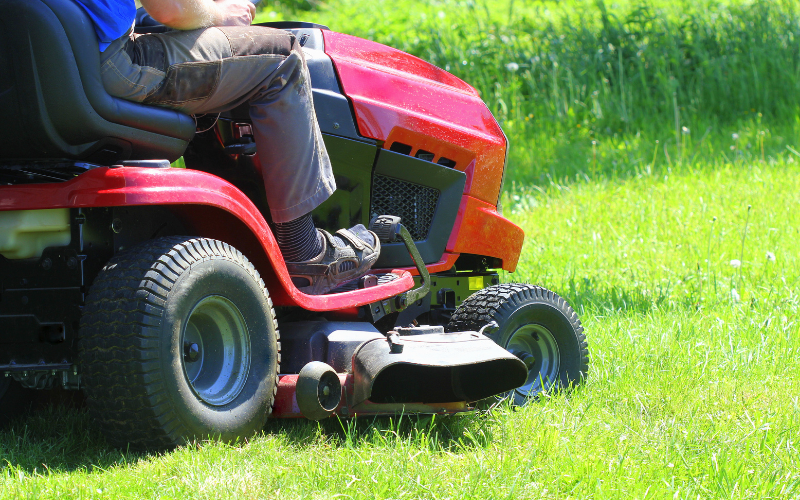Lawn mowers are important when it comes to taking care of turfgrass lawns. They can also be dangerous if misused. Many people end up in the emergency room every year from lawn mower injuries. Read on to learn the scope of the problem and how not to become a lawn mower accident statistic.

Lawn Mower Accident Statistics: Scope of the Problem
According to a study published in 2018 by Johns Hopkins University, injuries from lawn mowers send close to 6,400 people to emergency rooms every year. Most of these people require hospitalization, at an average cost of $37,000 an incident. Lacerations accounted for 46.7% of the injuries, followed by fractures (22.5%), and amputations (21.5%). The most common locations for injuries were wrists or hands (65.4%) and feet or toes (19.8%).
Who Gets Hurt
The information collected by Johns Hopkins University shows that men are overwhelmingly (85.2%) the people who get hurt. This study didn’t look at just adults. Children get injured too. Children under the age of four are six times more likely to have injuries on their feet, toes, or legs than children over the age of 15 and adults. They are 1.5 more times likely to have an amputation than children and adults over the age of 15. Children and adults over the age of 15 were 8.3% more likely to have injuries to their hands or arms.
How They Got Hurt
While the data was not detailed enough to tell if the injuries were caused by walk behind mowers or riding mowers, the research did suggest some common mechanisms of injury. Lacerations were commonly caused by objects thrown up by mowers and striking the operator. This was especially true if there were other machines being used to groom the landscape at the same time the mowing was taking place.
The other common cause of lacerations was sticking the hand into the mower’s discharge chute to clean out a clog. This can cause fractures and amputations, too. Some people failed to shut off the mower before trying to clean out the chute. Others shut off the mower but failed to realize the mower blades were under tension from a spring. When the obstruction was cleared, the spring released its tension, twirling the blades around and injuring the operator.
Foot injuries are mostly caused by pulling the lawn mower over the foot, especially when pulling the mower backward. If there was no safety skirting around the back of the mower, the operator may also stride too long and step under the mower.
Children aged four and younger overwhelmingly got hurt by falling off the lap of the lawn mower operator or being run over when the mower was backing. Children over the age of 15 were injured in the same ways adults were.
A study presented at the American Academy of Pediatrics showed that children (defined as 1-18 years of age) in rural areas got injured more often than children in urban areas. They state that 9,000 children are treated for lawn mower-related injuries each year. In rural areas, the children are younger, have more severe injuries, and have a higher rate of amputations. These children also have a higher rate of surgical complications and infections.

Riding/Zero Turn Lawn Mower Statistics: Professional Landscapers
Landscapers often use zero-turn radius riding mowers to landscape lawns. However, these are dangerous machines to operate. The U.S. Consumer Product Safety Commission estimates that over 35,000 injuries and hundreds of deaths occurred in 2019 due to all types of riding mowers. Some of these injuries were minor. However, landscaper deaths and injuries are tracked by the Occupational Safety and Health Administration, a division of the Department of Labor. They report 252 landscapers died of work-related injuries in 2019. Many of these accidents were zero-turn radius mower accidents that occurred when the mower overturned, and the worker was pinned under the mower. Even conventional riding mowers can turn over and pin the worker.
Lawn Mower Safety Tips
Injuries are not inevitable when using lawn mowers. They can be prevented by operating your push mower, zero-turn radius mower, or riding mower in a responsible way. Here are some tips to follow when mowing.
- Wear long pants and closed-toed shoes when mowing.
- Keep kids and pets inside during mowing.
- Read the manual and understand how to safely operate your machine.
- Before mowing, sweep the area and remove any rocks, sticks, toys, and anything else that the mower might throw.
- Wear safety glasses when mowing or using any power-operated equipment.
- Do not disable safety devices.
- If you are using a zero-turn radius mower, make sure it has a rollover protective device, commonly called a roll bar.
- If your riding mower has a rollover protective device, wear your seatbelt.
- Fuel your mower before use.
- Never add fuel to a hot lawn mower.
- Do not put your hands in the discharge chute for any reason.
- Clear discharge chute clogs with a stick instead of your hands.
- Never, ever, carry passengers on a riding mower.
- Do not operate any mower under the influence of alcohol or drugs.
Lawn mower manufacturers work hard to make a lawn mower safe, whether it is a push mower, riding mower, or zero-turn radius mower. Do your part by using common sense and following these tips so you do not end up being one of these lawn mower accidents statistics.


Hi, Tom
When I was 7 years old I was ran over by a lawnmower. I’m 48 now. I give safety meetings on lawnmower safety at work. Thank You in your efforts for raising awareness in this subject.
Thanks,Ken Paxton
Hi Ken,
I’m so sorry to hear about your story. I love mowing, but the equipment can be extremely dangerous when in untrained hands. I too know folks in my area that have had accidents (fortunately relatively minor), so I think it’s vital we emphasize the point of how to use this equipment safely.
I’m sure your safety meetings have a massive impact. Thank YOU for your efforts.
Take care, Tom.
Your numbers don’t add up there bub. How do we have 6,400 injuries a year with 9000 injuries to kids annually?
Hi Brad,
These are stats that are taken from two different studies that are separate from one another, hence why the figures don’t tally. Obviously these stats – like with any study – are a snapshot of reality. It’d be impossible to say the exact number of injuries in a year with absolute certainty.
I hope that clears it up. Sorry if I caused any confusion. I certainly didn’t mean to.
Thanks, Tom.